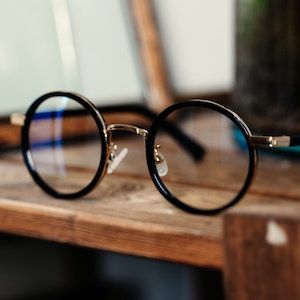Eyes with Geographic Atrophy Benefit from Low Vision Rehabilitation, New Study Finds
Low vision rehabilitation was associated with statistically significant increases in the overall composite score of a vision-related quality of life scale.
Credit: Bartosz Sujkowski/Unsplash

Low vision rehabilitation may be necessary for the treatment of geographic atrophy (GA) secondary to age-related macular degeneration (AMD), alongside multivitamin support and intravitreal anti-vascular endothelial growth factor (VEGF) injections, according to new research.
Results showed a statistically significant increase in overall composite scores and general vision scores obtained from the National Eye Institute Visual Function Questionnaire (NEI-VFQ-25) after 10.75 months of low vision rehabilitation in these eyes.
“We think that it is necessary to allocate sufficient time to patients with low vision in retina clinics, to provide education, and motivate them to use low vision aid devices,” wrote the investigative team, led by Damla Erginturk Acar, from the Ankara University Graduate Faculty of Health Sciences.
Estimates suggest that approximately 300 million people globally will have AMD by 2040, owing to increases in life expectancy.2 An advanced form of AMD, geographic atrophy is characterized by irreversible atrophy of the retinal pigment epithelium, photoreceptors, and choriocapillaris. Influenced by location and size, the advanced disease stage can have significant effects on visual function and vision-related quality of life.
Rehabilitation of low vision aims to restore a person’s independence by contributing to the functional use of their current vision levels. Acar and colleagues note there is no exact definition of success but may be achieved when a patient finds a helpful device and utilizes it to solve ≥1 vision problem. Near activities, including reading and seeing cell phones, are often most impacted and physicians frequently prescribe hyperocular glasses as near-vision aids.
In their analysis, Acar and colleagues aimed to evaluate low-vision rehabilitation methods in patients with AMD-related geographic atrophy and to evaluate the effect of vision rehabilitation on the quality of life in patients using the NEI-VFQ-25. The 2-part questionnaire, consisting of 25 main questions and 13 additional questions, was applied to all patients at the initial examination and ≥6 months after the initial examination. A total of 78 better-seeing eyes of 78 consecutive patients with geographic atrophy due to AMD who complained of difficulty performing daily taste were included in the study.
Study participants underwent detailed ophthalmological examination including the measurement of best-corrected visual acuity (BCVA) for near and distance and anterior and posterior segment examination. In the examinations, refraction errors were corrected and distance and near vision aid devices, including hyperocular glasses, magnifiers, telemicroscopes, and electro-optical devices, were evaluated for each individual patient and prescribed for near vision rehabilitation.
Of the 78 patients included in the study, 57 (73.1%) applied the rehabilitation methods and were considered the rehabilitation group. For the other 21 patients who did not apply these methods, they were designated as the control group.
Within the population, 29 (37.2%) patients were female and 49 (62.8%) were male. Fifty-seven (73.1%) patients who applied the rehabilitation methods were considered as a rehabilitation group, and 21 (26.9%) patients who did not apply these methods were considered the control group.
Mean BCVA at distance and near were significantly better in the rehabilitation group, compared to the control group (0.72 ± 0.26 vs. 0.85 ± 0.22 logMAR [P = .008]; 3.22 ± 2.97 vs. 4.30 ± 2.89 M [P = .039], respectively). The study showed that all participants' mean overall composite score of the quality-of-life questionnaire (n = 78) was 46.85 ± 11.58 points.
Upon analysis, investigators observed a statistically significant increase in the overall composite score, general vision, near activities, distance activities, and vision-specific variables after rehabilitation (P = .009 for general vision; P <.001 for others). However, no statistically significant change was found in the overall composite score or other subscales of the questionnaire in the control group (P >.05).
The analysis showed all patients were recommended to use ≥1 low-vision aid for near vision. Hyperocular glasses were recommended for 77 patients (98.72%), magnifiers for 15 patients (19.23%), electro-optical devices for 2 patients (2.56%), and telemicroscope for 1 patient (1.28%). Investigators noted 17 patients (21.8%) were prescribed more than 1 low-vision aid; however, for distance vision, only 29 patients (37.18%) received a recommendation for a low-vision aid.
Investigators noted the high levels of anxiety in those with progressive central vision loss, suggesting low vision rehabilitation will enable greater independence and confidence in these patients.
“Using their current functional vision capacity in the best way will enable them to become independent, self-sufficient, productive, self-confident, and happy individuals by enabling them to have social lives and increasing their quality of life,” investigators wrote.
References
- Erginturk Acar D, Batioglu F, Idil A, Sahli E, Goksuluk D. Rehabilitation Methods for Patients with Geographic Atrophy due to Age-Related Macular Degeneration and Effects of Rehabilitation on Quality of Life. J Ophthalmol. 2023;2023:3389750. Published 2023 Jul 8. doi:10.1155/2023/3389750
- W. L. Wong, X. Su, X. Li et al., “Global prevalence of age-related macular degeneration and disease burden projection for 2020 and 2040: a systematic review and meta-analysis,” Lancet Global Health, vol. 2, no. 2, pp. e106–e116, 2014.